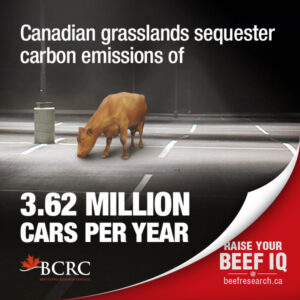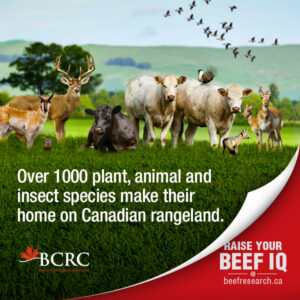Beef Production in a Changing Climate
As nations come together to discuss climate change and prioritize objectives to lower global greenhouse gas (GHG) emissions, meat consumption and livestock production are rightfully considered. All food production has environmental impacts. Unfortunately, concerns around the potential negative environmental impacts of beef often overshadow the beneficial impacts of the beef industry.
It is true that beef have a larger environmental footprint than chickens or swine. Cattle are bigger than chickens and pigs, so it takes more feed to grow them. Cattle are fed grains which require cropping systems that need tilling, fertilization and irrigation in some areas. However, those grains frequently aren’t originally intended for feed. Instead, they are often initially grown for more value-added markets (e.g., brewing, distilleries, flour), and only end up as feed after they fail to make the grade for human consumption. Cattle have always been excellent users of crop residues, forages, marginal land, and crop byproducts that are unsuitable for human consumption. Cattle can convert feed that humans can’t use into nutritious, high quality protein for people.
Cattle live longer than chickens and pigs, so they drink more water. But at the same time, the water that cattle drink returns to the water cycle, and cattle can contribute to the conservation of wetlands by preventing surface waters from being drained, providing important habitat for aquatic birds and mammals.
It takes more acres to raise beef cattle than other livestock because cattle are raised on less productive land. But these are often landscapes that have poor soil quality, steep hills, rocks and brushy areas that are not suited to crops, or pig, chicken or dairy barns. These rangelands are critical to the health of the planet, and grazing is necessary to keep them healthy.
Cattle produce more greenhouse gases than other livestock because they consume more high fiber, less digestible forage than other livestock, and rumen function produces methane. At the same time, the lands that grow grasses and legumes sequester carbon, thereby reducing GHGs, prevent erosion, help manage excess moisture and are biodiverse with numerous species of plants, animals and insects. Perennial rangeland can sequester anywhere from 50 to 200T of carbon per hectare.
Canada’s beef producers are inherently motivated to be more efficient. They work to reduce their use of expensive resources like land, feed, energy and water, improve range health and reduce nutrient and greenhouse gas losses. Improved production efficiencies have economic, social and environmental benefits.
Research helps to identify potential areas for improvement as well as help acknowledge the achievements that have been made in improving the footprint of the Canadian beef industry. With sound science, factual information can inform government policy, regulation decisions and consumer choices.
The Canadian Roundtable for Sustainable Beef is conducting a sustainability assessment for the Canadian beef industry which will serve as a scorecard that identifies where the industry is improving, and where it can still do better. Historical context will be provided by a Beef Science Cluster project led by Dr. Tim McAllister, a renowned Agriculture and Agri-food Canada scientist. That study will measure how Canada’s beef industry’s feed, land, and water use, greenhouse gas production, carbon sequestration and biodiversity have changed over the past 30 years.
Results on how many fewer resources are used and fewer GHGs emitted per kilogram of beef produced in 2011 compared to 1981 are expected in early 2016.
The foods that we enjoy, including protein sources, are not created equal. Some are more nutritious than others, and their production systems’ impacts vary drastically. These important differences need to be considered to make informed, balanced decisions and avoid unhelpful blanket statements.
If fact, one important way to lower beef’s environmental footprint is to reduce consumer waste. A 2011 FAO study found that the average North American consumer wastes 8-10% of meat products. The resources used to deliver nutrient dense beef onto someone’s plate should contribute to the nourishment of their body and not the size of their trash bag.
Learn more:
- Hot Air Doesn’t Just Come from Cattle (BCRC Blog post)
- Blame it on the Rain (BCRC Blog post)
- Defining the Environmental Hoofprint of Canadian Beef Production (BCRC Fact sheet)
- Canadian Beef Industry Sustainability Assessment (Canadian Roundtable for Sustainable Beef)
- Environmental Footprint of Beef Production (BCRC Web page)
- How Much Feed and Water are Used to Produce a Pound of Beef? (BCRC Blog post)
- Q&A on Conventional Production of Canadian Beef (BCRC blog post)
- Sustainable Beef (BCRC Blog post)
Click here to subscribe to the BCRC Blog and receive email notifications when new content is posted.
The sharing or reprinting of BCRC Blog articles is welcome and encouraged. Please provide acknowledgement to the Beef Cattle Research Council, list the website address, www.BeefResearch.ca, and let us know you chose to share the article by emailing us at [email protected].
We welcome your questions, comments and suggestions. Contact us directly or generate public discussion by posting your thoughts below.

